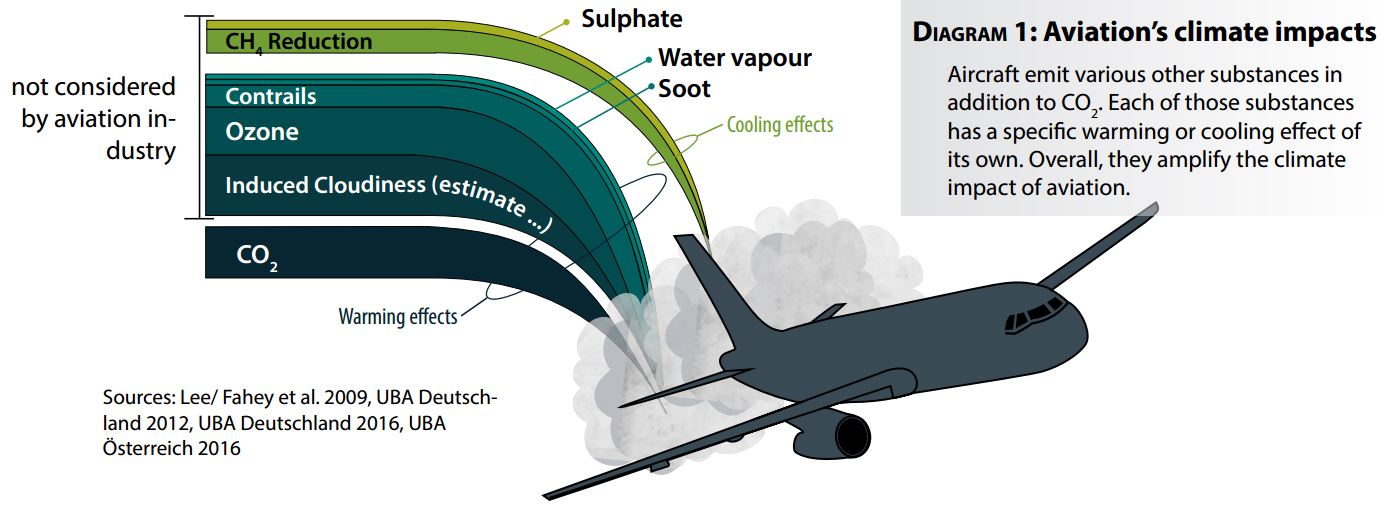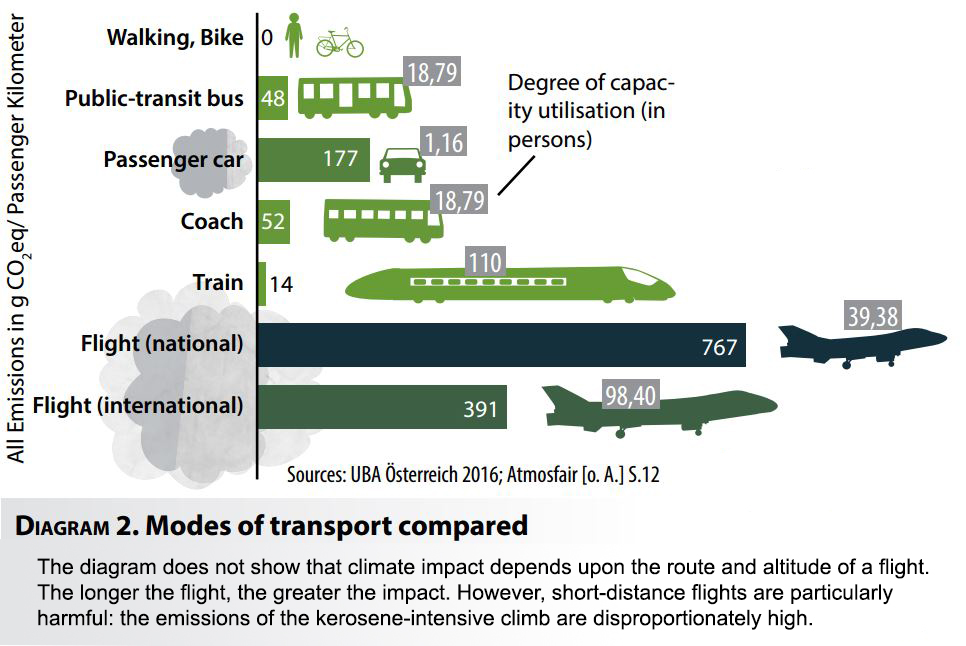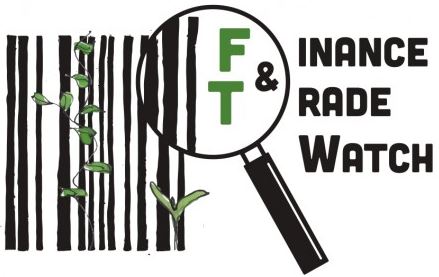This article is – with courtesy of Finance & Trade Watch, Vienna, Austria – published on our website. You can download the complete report here.
Aviation: The Fastest Way to Fry the Planet
Aviation is by far the mode of transport with the biggest climate impact (see DIAGRAM 2). Carbon dioxide (CO2) is only one part of the total climate impact of aviation (see DIAGRAM 1). If aviation was a country, it would be one of the TOP 10 emitters.
Emissions from aviation are rising more rapidly than any other sector of the economy. Te number of aircraft and the number of passenger-kilometres flown is expected to double over the next 20 years – entailing 550 new airports or airport expansions around the world (86 in Europe alone). This could cause the greenhouse gas emissions from aviation to increase four- to eight-fold by 2050.
At the turn of the millennium, less than 5% of the world’s population had ever sat in an aircraft. This goes at the expense of others: residents exposed to noise and particle pollution from the planes, local ecosystems, future generations and of those in the Global South who are already bearing the brunt of the impacts of the climate crisis.

Aviation Industry‘s Strategies: Green Growth or Greenwashing?
Pressure on the industry is rising. Aviation cannot anymore shirk responsibility for its contribution to the climate crisis. But how effective are the aviation‘s greening strategies? Te brochure ‘Te Illusion of Green Flying’ examines the different measures:
Innovations in Aviation Technology: Green flights would require quantum leaps in technology. Even the industry itself is now predicting that it will take at least 25 years to bring such innovation to technological maturity. And as aircraft have a lifespan of around 25 years, energy-intensive planes are likely to remain in use until at least the 2060s.
Sustainable Alternative Fuel: The ambition is to replace the highest possible proportion of conventional fuel with agrofuels. Te plan is not realistic because it would consume vast portions of land and risk food supply. This also risks land grabbing and would ultimately have minimum effects on the climate.

CORSIA – the international aviation‘s climate strategy: In 2016, ICAO (International Civil Aviation Organisation) agreed on a market-based measure called Carbon Offsetting and Reduction Scheme for International Aviation. Trough this measure, international aviation proclaims it‘s plan of ‘carbon neutral growth‘. Te plan relies almost entirely on offset measures: reductions of emissions from others elsewhere (see BOX).
Airport Carbon Accreditation: Airports increasingly present themselves as green, especially when they face opposition against planned expansions like new runways. They can become supposedly carbon-neutral airports via the ACA certification scheme. For the ACA scheme, as with CORSIA, carbon offsetting is needed. An airport can call itself carbon neutral even though the airport‘s flights, and therefore around 95% of the emissions, are not at all factored.
Biodiversity Offsetting: Airports take up large areas which can be important for biodiversity and local inhabitants. Therefore, pressure is usually big to compensate for this damage and disruption; in some cases airports are obliged by law to compensate. Compensation means that an ecosystem can be destroyed, if nature is protected elsewhere. Social consequences of the destruction are ignored. Methodological flaws in the ‘replacement’ of nature are widespread, and compensation often fails.
Climate Neutral Flights Offers by Airlines: Almost a third of airlines offer their customers carbon-neutral travel. For years, the offer of climate-neutral flights has helped to nurture the illusion that flying green and carbon offsetting are possible. Offers of individual credits thus prepared the way for programmes such as CORSIA, which relieve a whole industry of the responsibility for reducing greenhouse gas emissions.
What is really needed: less air travel, not more
The brochure shows that carbon neutral growth remains an illusion, that the green strategies cause new problems and are neocolonial, and lastly the aviation industry uses them as a trade in indulgences and a diversionary manoeuvre. The aviation industry greenwashes its public image, avoiding or preventing more effective strategies that would curtail its profit. Such approaches to reduce aviation growth, however, are needed urgently to both address the climate crisis effectively and equitably.
It is therefore essential to cut aviation‘s privileges: Finally, taxes on kerosene, flight tickets and airport property need to be introduced. In the European Union alone, the losses in state revenue due to aviation subsidies amount to 30 – 40 billion Euros annually.
If night trains no longer run, booking train tickets for cross-border journeys becomes increasingly difficult, and the only transatlantic passenger ships are luxury cruiseliners, flying will remain the preferred option for many. It is therefore hugely important to stand up for these alternatives. At the same time, resistance against airport projects can prevent locking-in an emissions-intensive, destructive form of mobility for decades into the future.
More and more actors are building alliances to apply pressure and make the needed change together – some of the actors and needed strategies are presented in the brochure.
| Emissions offsetting: a modern sale of indulgences Offset projects involve for example generating energy from methane (which is produced in large quantities in industrial livestock farming), or building hydropower plants that claim to prevent production of energy from fossil fuels. Forest conservation projects and operators of tree plantations can also sell such offset credits representing supposedly achieved emission savings for the aviation industry. Studies show that the majority of projects miscalculate their savings. The research institute Öko-Institut investigated the effectiveness of existing offsetting projects for the European Commission and concluded that only for 2% of the offset projects it is highly likely that they resulted in actual additional emissions reduction. If for example a hydropower plant is being built anyway, or a forest is foreseen to be cut, such projects should not be eligible for selling carbon credits – which in turn allow others to pollute more. Also, the projects which are largely located in the Global South, often lead to local conflicts or land grabbing. This is especially the case with land or forest based projects like REDD+. Ultimately, offsetting is unjust: To enable a small portion of the world to continue taking more and more flights with a clear environmental conscience, others have to reduce their greenhouse gas emissions: people whose emissions are often already very low, whose historical contribution to climate change is negligible and who are already experiencing the impacts of the climate crisis. |
|---|
| A brochure by: Finance & Trade Watch, November 2017 Download: www.ftwatch.at/flying_green Contact: [email protected] / [email protected] |  |
|---|

